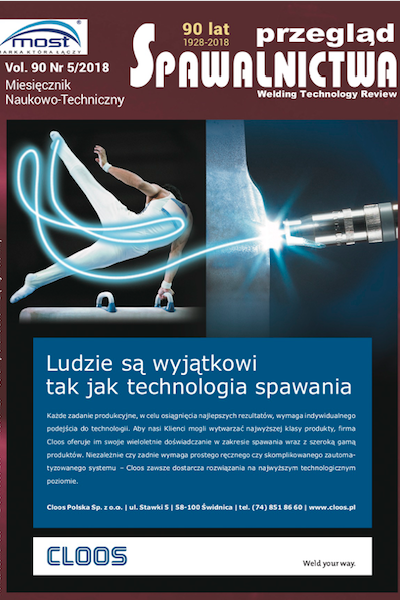Effect of austenitizing temperature on the microstructure and hardness of Hardox 450 steel
Main Article Content
Abstract
The paper presents the simulation of the temperature effect on phase transformation in the heat-affected zone in the area of superheat temperatures. Five different tempera- tures were selected, i.e. 900, 1000, 1100, 1200 and 1300 ÌŠC. Heating and cooling simulations were carried out on the L78 R.I.T.A high-resolution dilatometer. After austenitizing, the samples were cooled with two selected rates 5 and 1 ÌŠC/s. On the samples after cooling, microstructure analysis and hardness distribution analysis were performed. Based on the results, the influence of temperature on the increase of hardenability in the range of the tested cooling rates was determined and as a consequence changes in the microstructure and homogeneity of the obtained hardness maps.
in polish
Wpływ temperatury austenizowania na mikrostrukturę i twardość stali typu Hardox 450
W pracy przedstawiono symulację wpływu temperatury na zakres przemian fazowych w strefie wpływu ciepła w obszarze temperatur przegrzania. Wybrano pięć różnych temperatur austenityzowania, tj.: 900, 1000, 1100, 1200 oraz 1300 ÌŠC. Symulacje nagrzewania i chłodzenia wykonano na wysokorozdzielczym dylatometrze L78 R.I.T.A. Po austenityzowaniu, próbki chłodzono z dwoma wybranymi szybkościami 5 i 1 ÌŠC/s do temperatury pokojowej. Na próbkach po ochłodzeniu wykonano analizę mikrostruktury i twardości. W oparciu o przedstawione wyniki określono wpływ temperatury na hartowność w zakresie badanych szybkości chodzenia i w konsekwencji zmian w mikrostrukturze oraz jednorodności uzyskanych map twardości.
Downloads
Article Details
Creative Commons CC BY 4.0 https://creativecommons.org/licenses/by/4.0/
Welding Technology Review (WTR) articles are published open access under a CC BY licence (Creative Commons Attribution 4.0 International licence). The CC BY licence is the most open licence available and considered the industry 'gold standard' for open access; it is also preferred by many funders. This licence allows readers to copy and redistribute the material in any medium or format, and to alter, transform, or build upon the material, including for commercial use, providing the original author is credited.
References
Hardox Das Verschleiβblech der vielen Möglichkeiten, Wydawnictwo SSAB, Oxelösund, 2002.
Dudziński W., Konat Ł., Pękalska L., Pękalski G.: Struktury i właściwości stali Hardox 450 i Hardox 500, Inżynieria Mater. 3, 2006, s. 139-142.
Pękalski G., Konat Ł.: Rozpoznanie i analiza efektów zastosowań stali Hardox, Rap. Inst. Mater. I Mech. Tech. Serii SPR 4/2005.
Pawlak K.: A review of high-strength wear resistant steel hardox, 2015.
Konat Ł., Pękalski G.: Rozpoznanie i analiza efektów zastosowań stali Hardox, Raport PWr serii SPR, 2005.
Malkiewicz T.: Metaloznawstwo stopów żelaza, 2nd ed., PWN, Warszawa Kraków, 1978.
Blicharski M.: Inżynieria materiałowa. Stal, Wydawnictwa Naukowo-Techniczne, Warszawa 2004, n.d.
Sotskov N.I., Goritskii V.M., Morozova L.M.: Effect of Tempering Temperature on The Resistance of High- Strength Steel 40Kh Bolts To Corrosion Cracking, Metalloved. I Termicheskaya Obrab. Met. 292, 1992, pp. 4-7.
Mulholland M.D., Seidman D.N.: Nanoscale co-precipitation and mechanical properties of a high-strength low-carbon steel, Acta Mater. 59, 2011, pp. 1881-1897.
Mikuła J.: Spawalność Stali, Zeszty Naukowe Politechniki Krakowskiej, 2001.
Kostin V.: Microstructure of Haz Metal of Joints of High-Strength Structural Steel Weldox 1300, 2015.
PracaZbiorowa, Poradnik inżyniera spawalnictwo, Wydawnictwo Naukowo-Techniczne, Warszawa, 1983.
Tasak E.: Spawalność stali, FOTOBIT, Kraków, 2002.
